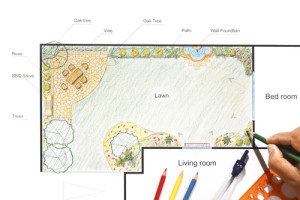Garden Design for Clay Soils
 Clay soil is definitely an acquired taste for most gardeners, yet you might start swearing by clay soil once you hear some of the benefits listed below. First, though, what the heck is clay soil and how can it benefit your garden?
Clay soil is definitely an acquired taste for most gardeners, yet you might start swearing by clay soil once you hear some of the benefits listed below. First, though, what the heck is clay soil and how can it benefit your garden?
Clay Soil Vs. The Competition
Generally when you walk into a nursery, outdoors department or speak with a landscape maintenance company, you might be steered more towards silt soils or loam soils before clay. That’s because clay soil is composed of tiny plates or granules that can harden over time.
You’ve no doubt had the experience of plunking your shovel down into the ground, ready to get your garden going in the spring, and run up against clay. In spite of its hardness, though, clay soil is great for retaining moisture, nourishing your garden as well as retaining nutrients and fertilizers between individual clay particles.
Loam, relatedly, is a combination of clay, sand and silt and is very versatile, moldable and just easy for even inexperienced gardeners to work with.
Benefits of Clay
Part of the reason that loam soil is so moldable, to our main point, is that loam contains clay. The clay in the loam ensures that what you’re working with clumps into granules whereas the silt and clay components of loam help to retain moisture and nourish the plants in your garden.
Clay soil works wonderfully for annuals as well as perennial plants since the clay allows these plants to get a firm (and nourishing!) hold with their roots. The grip that perennials and annuals get with clay can withstand otherwise harsh humidity and temperature changes.
In short, clay’s fantastic as a garden design foundation since it provides a hearty root structure and allows plants to withstand harsh conditions. Moreover, you won’t need to water or fertilize as much with clay as with other soils. All good things.
Working with Clay Soil
Clay soil as a garden design foundation can accommodate a pretty wide range of shrubs, climbers, conifers and trees. Everything from popular conifers like ginkgo biloba and a deciduous evergreen like cotoneaster to rosa and fuchsia shrubs makes a great complement to clay soil.
To provide even more nutrients for these clay-compatible shrubs and conifers try adding a light mulch to your garden. Leafmold, composted bark and long manure work especially well with clay soil in terms of providing an easy-to-work-with mulch that does wonders for your plants.
Mulching Your Clay Foundation
When you actually get down to planting, mulching the plants up to three inches is a good idea for a few reasons.
Just a few inches down allows the right amount of moisture to hit your plants’ roots while tamping down weed growth and providing shielding from the elements.
One problem that people have with clay soil is that they sometimes overwater. Remember that clay soil retains water and moisture better than other garden foundations and, therefore, doesn’t need around-the-clock watering.
You’ll know that you’re doing too much watering when you notice a lot of the plants visibly retaining water and you notice globs of water on the clay surface the next day. These would both indicate that it’s time to cut back and let clay soil work its magic.
Creating the Perfect Garden
If you understand how clay’s small granules retain moisture and you know not to overwater, clay can offer a ton of benefits beyond more favored soil types.
You might consider planting eucalyptus trees, gorgeous flowering plants like bergenias and some of the conifers mentioned above for the perfect garden design. Contact Xeriscape today to get started.
Tagged: DK Landscaping, garden, garden design, gardening, landscape, landscaping
Both comments and pings are currently closed.





